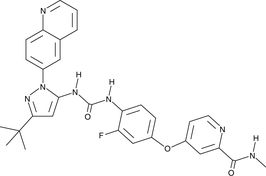Cayman
Showing 37501–37650 of 45550 results
-
RCS-4 (Item No. 10645) is a synthetic cannabinoid which has been detected in herbal mixtures.{19508} RCS-4 M11 metabolite is a major urinary metabolite of RCS-4.{21303} It is derived by O-demethylation and oxidation of the N-pentyl chain to a ketone on the parent compound. This metabolite is potentially useful as a metabolic marker for the identification of RCS-4 ingestion and is intended for research and forensic purposes.
Brand:CaymanSKU:11979 - 1 mgAvailable on backorder
RCS-4 (Item No. 10645) is a synthetic cannabinoid which has been detected in herbal mixtures.{19508} RCS-4 M11 metabolite is a major urinary metabolite of RCS-4.{21303} It is derived by O-demethylation and oxidation of the N-pentyl chain to a ketone on the parent compound. This metabolite is potentially useful as a metabolic marker for the identification of RCS-4 ingestion and is intended for research and forensic purposes.
Brand:CaymanSKU:11979 - 10 mgAvailable on backorder
RCS-4 (Item No. 10645) is a synthetic cannabinoid which has been detected in herbal mixtures.{19508} RCS-4 M11 metabolite is a major urinary metabolite of RCS-4.{21303} It is derived by O-demethylation and oxidation of the N-pentyl chain to a ketone on the parent compound. This metabolite is potentially useful as a metabolic marker for the identification of RCS-4 ingestion and is intended for research and forensic purposes.
Brand:CaymanSKU:11979 - 5 mgAvailable on backorder
RCS-4 is a synthetic cannabinoid (CB) which has been detected in herbal mixtures.{19508} RCS-4 M9 metabolite is an expected metabolite of RCS-4 (Item No. 10645), characterized by hydroxylation on both the alkyl and phenyl groups. Such dihydroxylated metabolites have been shown to result during the metabolism of similar synthetic CBs both in vitro, with liver microsomes, and in vivo.{19353,18292,18291} This product is intended for research and forensic purposes.
Brand:CaymanSKU:11977 - 1 mgAvailable on backorder
RCS-4 is a synthetic cannabinoid (CB) which has been detected in herbal mixtures.{19508} RCS-4 M9 metabolite is an expected metabolite of RCS-4 (Item No. 10645), characterized by hydroxylation on both the alkyl and phenyl groups. Such dihydroxylated metabolites have been shown to result during the metabolism of similar synthetic CBs both in vitro, with liver microsomes, and in vivo.{19353,18292,18291} This product is intended for research and forensic purposes.
Brand:CaymanSKU:11977 - 10 mgAvailable on backorder
RCS-4 is a synthetic cannabinoid (CB) which has been detected in herbal mixtures.{19508} RCS-4 M9 metabolite is an expected metabolite of RCS-4 (Item No. 10645), characterized by hydroxylation on both the alkyl and phenyl groups. Such dihydroxylated metabolites have been shown to result during the metabolism of similar synthetic CBs both in vitro, with liver microsomes, and in vivo.{19353,18292,18291} This product is intended for research and forensic purposes.
Brand:CaymanSKU:11977 - 5 mgAvailable on backorder
RCS-4 is structurally similar to certain JWH compounds, synthetic cannabinoids used in herbal mixtures. RCS-4 itself has been identified in herbal mixtures.{19508} RCS-4 N-(4-hydroxypentyl) metabolite is a potential metabolite of RCS-4.
Brand:CaymanSKU:10936 - 1 mgAvailable on backorder
RCS-4 is structurally similar to certain JWH compounds, synthetic cannabinoids used in herbal mixtures. RCS-4 itself has been identified in herbal mixtures.{19508} RCS-4 N-(4-hydroxypentyl) metabolite is a potential metabolite of RCS-4.
Brand:CaymanSKU:10936 - 10 mgAvailable on backorder
RCS-4 is structurally similar to certain JWH compounds, synthetic cannabinoids used in herbal mixtures. RCS-4 itself has been identified in herbal mixtures.{19508} RCS-4 N-(4-hydroxypentyl) metabolite is a potential metabolite of RCS-4.
Brand:CaymanSKU:10936 - 5 mgAvailable on backorder
RCS-4 is a synthetic cannabinoid which is structurally similar to JWH 018. Like JWH 018, RCS-4 has been detected in herbal products.{19508} RCS-4 N-(5-carboxypentyl) metabolite is an expected metabolite of RCS-4. Carboxylation of the N-alkyl chain of JWH 018 occurs during in vivo metabolism, resulting in a 5-carboxypentyl metabolite that is detectable in the urine.{18291}
Brand:CaymanSKU:10937 - 1 mgAvailable on backorder
RCS-4 is a synthetic cannabinoid which is structurally similar to JWH 018. Like JWH 018, RCS-4 has been detected in herbal products.{19508} RCS-4 N-(5-carboxypentyl) metabolite is an expected metabolite of RCS-4. Carboxylation of the N-alkyl chain of JWH 018 occurs during in vivo metabolism, resulting in a 5-carboxypentyl metabolite that is detectable in the urine.{18291}
Brand:CaymanSKU:10937 - 10 mgAvailable on backorder
RCS-4 is a synthetic cannabinoid which is structurally similar to JWH 018. Like JWH 018, RCS-4 has been detected in herbal products.{19508} RCS-4 N-(5-carboxypentyl) metabolite is an expected metabolite of RCS-4. Carboxylation of the N-alkyl chain of JWH 018 occurs during in vivo metabolism, resulting in a 5-carboxypentyl metabolite that is detectable in the urine.{18291}
Brand:CaymanSKU:10937 - 5 mgAvailable on backorder
RCS-4 is structurally similar to certain JWH compounds, synthetic cannabinoids used in herbal mixtures meant to mimic cannabis. RCS-4 itself has been identified in herbal mixtures.{19508} RCS-4 N-(5-hydroxypentyl) metabolite is a potential metabolite of RCS-4. A similar JWH metabolite has been detected in human urine following JWH smoking.{18291} This metabolite is almost completely glucuroconjugated in urine samples, requiring enzymolysis of the sample before analysis.{18291}
Brand:CaymanSKU:10935 - 1 mgAvailable on backorder
RCS-4 is structurally similar to certain JWH compounds, synthetic cannabinoids used in herbal mixtures meant to mimic cannabis. RCS-4 itself has been identified in herbal mixtures.{19508} RCS-4 N-(5-hydroxypentyl) metabolite is a potential metabolite of RCS-4. A similar JWH metabolite has been detected in human urine following JWH smoking.{18291} This metabolite is almost completely glucuroconjugated in urine samples, requiring enzymolysis of the sample before analysis.{18291}
Brand:CaymanSKU:10935 - 10 mgAvailable on backorder
RCS-4 is structurally similar to certain JWH compounds, synthetic cannabinoids used in herbal mixtures meant to mimic cannabis. RCS-4 itself has been identified in herbal mixtures.{19508} RCS-4 N-(5-hydroxypentyl) metabolite is a potential metabolite of RCS-4. A similar JWH metabolite has been detected in human urine following JWH smoking.{18291} This metabolite is almost completely glucuroconjugated in urine samples, requiring enzymolysis of the sample before analysis.{18291}
Brand:CaymanSKU:10935 - 5 mgAvailable on backorder
RCS-4 (Item No. 10645) is a cannabimimetic compound similar to JWH 018, a potent cannabinoid receptor agonist. RCS-4, like JWH 018, has been identified in herbal blends. RCS-4-C4 homolog is identical to RCS-4 except the N-1 alkyl chain length has been shortened from C5 to C4. It has also been detected in herbal blends. The biological activities of RCS-4-C4 homolog have not been reported.
Brand:CaymanSKU:10798 - 1 mgAvailable on backorder
RCS-4 (Item No. 10645) is a cannabimimetic compound similar to JWH 018, a potent cannabinoid receptor agonist. RCS-4, like JWH 018, has been identified in herbal blends. RCS-4-C4 homolog is identical to RCS-4 except the N-1 alkyl chain length has been shortened from C5 to C4. It has also been detected in herbal blends. The biological activities of RCS-4-C4 homolog have not been reported.
Brand:CaymanSKU:10798 - 10 mgAvailable on backorder
RCS-4 (Item No. 10645) is a cannabimimetic compound similar to JWH 018, a potent cannabinoid receptor agonist. RCS-4, like JWH 018, has been identified in herbal blends. RCS-4-C4 homolog is identical to RCS-4 except the N-1 alkyl chain length has been shortened from C5 to C4. It has also been detected in herbal blends. The biological activities of RCS-4-C4 homolog have not been reported.
Brand:CaymanSKU:10798 - 5 mgAvailable on backorder
RCS-8 is a synthetic cannabinoid that has been identified as a component of several different herbal incense products. As an analog of JWH 250 (Item No. 13634), a cyclohexylethyl ring at the indole nitrogen replaces the pentyl chain. Though speculated to be less potent than JWH 250, the biological activity of RCS-8 has not been reported.
Brand:CaymanSKU:-RCS-8 is a synthetic cannabinoid that has been identified in extracts from herbal synthetic cannabis blends. Chemically, RCS-8 can be described as 1-(2-cyclohexylethyl)-3-(2-methoxyphenylacetyl)indole. RCS-8 3-methyl isomer differs from RCS-8 by having a methoxy group at the 3, rather than 2, position of its phenylacetyl group. The biological activity of this compound has not been evaluated.
Brand:CaymanSKU:10864 - 1 mgAvailable on backorder
RCS-8 is a synthetic cannabinoid that has been identified in extracts from herbal synthetic cannabis blends. Chemically, RCS-8 can be described as 1-(2-cyclohexylethyl)-3-(2-methoxyphenylacetyl)indole. RCS-8 3-methyl isomer differs from RCS-8 by having a methoxy group at the 3, rather than 2, position of its phenylacetyl group. The biological activity of this compound has not been evaluated.
Brand:CaymanSKU:10864 - 10 mgAvailable on backorder
RCS-8 is a synthetic cannabinoid that has been identified in extracts from herbal synthetic cannabis blends. Chemically, RCS-8 can be described as 1-(2-cyclohexylethyl)-3-(2-methoxyphenylacetyl)indole. RCS-8 3-methyl isomer differs from RCS-8 by having a methoxy group at the 3, rather than 2, position of its phenylacetyl group. The biological activity of this compound has not been evaluated.
Brand:CaymanSKU:10864 - 5 mgAvailable on backorder
RCS-8 is a synthetic cannabinoid that has been identified in extracts from herbal synthetic cannabis blends. Chemically, RCS-8 can be described as 1-(2-cyclohexylethyl)-3-(2-methoxyphenylacetyl)indole. RCS-8 4-methyl isomer differs from RCS-8 by having a methoxy group at the 4, rather than 2, position of its phenylacetyl group. The biological activity of this compound has not been evaluated.
Brand:CaymanSKU:10863 - 1 mgAvailable on backorder
RCS-8 is a synthetic cannabinoid that has been identified in extracts from herbal synthetic cannabis blends. Chemically, RCS-8 can be described as 1-(2-cyclohexylethyl)-3-(2-methoxyphenylacetyl)indole. RCS-8 4-methyl isomer differs from RCS-8 by having a methoxy group at the 4, rather than 2, position of its phenylacetyl group. The biological activity of this compound has not been evaluated.
Brand:CaymanSKU:10863 - 10 mgAvailable on backorder
RCS-8 is a synthetic cannabinoid that has been identified in extracts from herbal synthetic cannabis blends. Chemically, RCS-8 can be described as 1-(2-cyclohexylethyl)-3-(2-methoxyphenylacetyl)indole. RCS-8 4-methyl isomer differs from RCS-8 by having a methoxy group at the 4, rather than 2, position of its phenylacetyl group. The biological activity of this compound has not been evaluated.
Brand:CaymanSKU:10863 - 5 mgAvailable on backorder
Resolvin conjugate in tissue regeneration 1 (RCTR1) is a specialized pro-resolving mediator (SPM) biosynthesized from docosahexaenoic acid (DHA; Item No. 90310) by isolated human macrophages and apoptotic polymorphonuclear (PMN) neutrophils.{54253} It has been found in human spleen and bone marrow.{54255} RCTR1 is produced via lipoxygenase-mediated oxidation of DHA to 7(S)-8-epoxy-17(S)-HDHA, which is conjugated to glutathione.{54253,54255,54254} RCTR1 (10 nM) increases phagocytosis of E. coli or apoptotic neutrophils in isolated human monocyte-derived macrophages.{54255} It decreases chemotaxis induced by leukotriene B4 (LTB4; Item No. 20110) in isolated human neutrophils when used at a concentration of 10 nM. RCTR1 (1 and 10 nM) accelerates tissue regeneration in planaria. Intraperitoneal administration of RCTR1 (100 ng/animal) shortens the inflammatory resolution period and decreases inflammatory exudate neutrophil infiltration in a mouse model of E. coli-induced peritonitis.
Brand:CaymanSKU:24896 - 10 µgAvailable on backorder
Resolvin conjugate in tissue regeneration 1 (RCTR1) is a specialized pro-resolving mediator (SPM) biosynthesized from docosahexaenoic acid (DHA; Item No. 90310) by isolated human macrophages and apoptotic polymorphonuclear (PMN) neutrophils.{54253} It has been found in human spleen and bone marrow.{54255} RCTR1 is produced via lipoxygenase-mediated oxidation of DHA to 7(S)-8-epoxy-17(S)-HDHA, which is conjugated to glutathione.{54253,54255,54254} RCTR1 (10 nM) increases phagocytosis of E. coli or apoptotic neutrophils in isolated human monocyte-derived macrophages.{54255} It decreases chemotaxis induced by leukotriene B4 (LTB4; Item No. 20110) in isolated human neutrophils when used at a concentration of 10 nM. RCTR1 (1 and 10 nM) accelerates tissue regeneration in planaria. Intraperitoneal administration of RCTR1 (100 ng/animal) shortens the inflammatory resolution period and decreases inflammatory exudate neutrophil infiltration in a mouse model of E. coli-induced peritonitis.
Brand:CaymanSKU:24896 - 100 µgAvailable on backorder
Resolvin conjugate in tissue regeneration 1 (RCTR1) is a specialized pro-resolving mediator (SPM) biosynthesized from docosahexaenoic acid (DHA; Item No. 90310) by isolated human macrophages and apoptotic polymorphonuclear (PMN) neutrophils.{54253} It has been found in human spleen and bone marrow.{54255} RCTR1 is produced via lipoxygenase-mediated oxidation of DHA to 7(S)-8-epoxy-17(S)-HDHA, which is conjugated to glutathione.{54253,54255,54254} RCTR1 (10 nM) increases phagocytosis of E. coli or apoptotic neutrophils in isolated human monocyte-derived macrophages.{54255} It decreases chemotaxis induced by leukotriene B4 (LTB4; Item No. 20110) in isolated human neutrophils when used at a concentration of 10 nM. RCTR1 (1 and 10 nM) accelerates tissue regeneration in planaria. Intraperitoneal administration of RCTR1 (100 ng/animal) shortens the inflammatory resolution period and decreases inflammatory exudate neutrophil infiltration in a mouse model of E. coli-induced peritonitis.
Brand:CaymanSKU:24896 - 25 µgAvailable on backorder
Resolvin conjugate in tissue regeneration 1 (RCTR1) is a specialized pro-resolving mediator (SPM) biosynthesized from docosahexaenoic acid (DHA; Item No. 90310) by isolated human macrophages and apoptotic polymorphonuclear (PMN) neutrophils.{54253} It has been found in human spleen and bone marrow.{54255} RCTR1 is produced via lipoxygenase-mediated oxidation of DHA to 7(S)-8-epoxy-17(S)-HDHA, which is conjugated to glutathione.{54253,54255,54254} RCTR1 (10 nM) increases phagocytosis of E. coli or apoptotic neutrophils in isolated human monocyte-derived macrophages.{54255} It decreases chemotaxis induced by leukotriene B4 (LTB4; Item No. 20110) in isolated human neutrophils when used at a concentration of 10 nM. RCTR1 (1 and 10 nM) accelerates tissue regeneration in planaria. Intraperitoneal administration of RCTR1 (100 ng/animal) shortens the inflammatory resolution period and decreases inflammatory exudate neutrophil infiltration in a mouse model of E. coli-induced peritonitis.
Brand:CaymanSKU:24896 - 50 µgAvailable on backorder
RD162 is a second-generation androgen receptor (AR) antagonist. It inhibits binding of 18F-FDHT to AR in human prostate cancer cells with an IC50 value of 30.9 nM.{24601} RD162 completely suppresses VCaP cell proliferation at 1 µM and induces apoptosis of VCaP cells at 10 µM. RD162 is bioavailable and reduces LNCaP/AR tumor growth in castrated male mice at a daily oral dose of 10 mg/kg.{24601}
Brand:CaymanSKU:13039 - 1 mgAvailable on backorder
RD162 is a second-generation androgen receptor (AR) antagonist. It inhibits binding of 18F-FDHT to AR in human prostate cancer cells with an IC50 value of 30.9 nM.{24601} RD162 completely suppresses VCaP cell proliferation at 1 µM and induces apoptosis of VCaP cells at 10 µM. RD162 is bioavailable and reduces LNCaP/AR tumor growth in castrated male mice at a daily oral dose of 10 mg/kg.{24601}
Brand:CaymanSKU:13039 - 10 mgAvailable on backorder
RD162 is a second-generation androgen receptor (AR) antagonist. It inhibits binding of 18F-FDHT to AR in human prostate cancer cells with an IC50 value of 30.9 nM.{24601} RD162 completely suppresses VCaP cell proliferation at 1 µM and induces apoptosis of VCaP cells at 10 µM. RD162 is bioavailable and reduces LNCaP/AR tumor growth in castrated male mice at a daily oral dose of 10 mg/kg.{24601}
Brand:CaymanSKU:13039 - 25 mgAvailable on backorder
RD162 is a second-generation androgen receptor (AR) antagonist. It inhibits binding of 18F-FDHT to AR in human prostate cancer cells with an IC50 value of 30.9 nM.{24601} RD162 completely suppresses VCaP cell proliferation at 1 µM and induces apoptosis of VCaP cells at 10 µM. RD162 is bioavailable and reduces LNCaP/AR tumor growth in castrated male mice at a daily oral dose of 10 mg/kg.{24601}
Brand:CaymanSKU:13039 - 5 mgAvailable on backorder
ReAsH-EDT2 is a fluorescent, membrane-permeable biarsenical compound that binds covalently to tetracysteine sequences, which are engineered into target proteins.{31942} It binds proteins that have the tetracysteine tag almost immediately after translation.{31942} ReAsH-EDT2 is commonly used to study protein trafficking, folding, and interactions in living cells or cell lysates.{31942,31940,31941} This red-emitting fluorophore is excited at 593 nm, with emission at 608 nm.{31941}
Brand:CaymanSKU:19767 -Available on backorder
Rebamipide is a quinolinone derivative that stimulates endogenous PGE2 generation in gastric mucosa, enhancing gastric mucosal defense in a COX-2-dependent manner.{28199} Rebamipide has been shown to inhibit the production of reactive oxygen species and to decrease cytokine release induced by H. pylori infection.{28199} A daily oral dose of 100 mg/kg was found to be protective against the development of pyloric channel ulcers in Mongolian gerbils infected with H. pylori.{28199} In addition to the stomach, rebamipide can also enhance secretion of mucin covering the conjunctiva and cornea, which is important for tear film adhesion.{28200}
Brand:CaymanSKU:-Out of stock
Rebamipide is a quinolinone derivative that stimulates endogenous PGE2 generation in gastric mucosa, enhancing gastric mucosal defense in a COX-2-dependent manner.{28199} Rebamipide has been shown to inhibit the production of reactive oxygen species and to decrease cytokine release induced by H. pylori infection.{28199} A daily oral dose of 100 mg/kg was found to be protective against the development of pyloric channel ulcers in Mongolian gerbils infected with H. pylori.{28199} In addition to the stomach, rebamipide can also enhance secretion of mucin covering the conjunctiva and cornea, which is important for tear film adhesion.{28200}
Brand:CaymanSKU:-Out of stock
Rebamipide is a quinolinone derivative that stimulates endogenous PGE2 generation in gastric mucosa, enhancing gastric mucosal defense in a COX-2-dependent manner.{28199} Rebamipide has been shown to inhibit the production of reactive oxygen species and to decrease cytokine release induced by H. pylori infection.{28199} A daily oral dose of 100 mg/kg was found to be protective against the development of pyloric channel ulcers in Mongolian gerbils infected with H. pylori.{28199} In addition to the stomach, rebamipide can also enhance secretion of mucin covering the conjunctiva and cornea, which is important for tear film adhesion.{28200}
Brand:CaymanSKU:-Out of stock
Rebamipide is a quinolinone derivative that stimulates endogenous PGE2 generation in gastric mucosa, enhancing gastric mucosal defense in a COX-2-dependent manner.{28199} Rebamipide has been shown to inhibit the production of reactive oxygen species and to decrease cytokine release induced by H. pylori infection.{28199} A daily oral dose of 100 mg/kg was found to be protective against the development of pyloric channel ulcers in Mongolian gerbils infected with H. pylori.{28199} In addition to the stomach, rebamipide can also enhance secretion of mucin covering the conjunctiva and cornea, which is important for tear film adhesion.{28200}
Brand:CaymanSKU:-Out of stock
Rebastinib is an orally bioavailable tyrosine kinase inhibitor that inhibits Abl1 (IC50 = 0.8 nM) as well as the gatekeeper mutant Abl1T315I (IC50 = 4 nM) and the activation loop mutant Abl1H396P.{34442} It also inhibits the Src family kinases Src, Lyn, Fgr, and Hck and the tyrosine kinases KDR, FLT3, and Tie2 at nanomolar concentrations. Rebastinib inhibits mutant Abl1T315I signaling and prolongs survival in a mouse Ba/F3 cell allograft model.{34442,34443} Rebastinib also exhibits in vivo antineoplastic activity against cells with the T674I point mutation of FIP1-like-1-platelet-derived growth factor receptor α.{34444}
Brand:CaymanSKU:21465 -Out of stock
Rebastinib is an orally bioavailable tyrosine kinase inhibitor that inhibits Abl1 (IC50 = 0.8 nM) as well as the gatekeeper mutant Abl1T315I (IC50 = 4 nM) and the activation loop mutant Abl1H396P.{34442} It also inhibits the Src family kinases Src, Lyn, Fgr, and Hck and the tyrosine kinases KDR, FLT3, and Tie2 at nanomolar concentrations. Rebastinib inhibits mutant Abl1T315I signaling and prolongs survival in a mouse Ba/F3 cell allograft model.{34442,34443} Rebastinib also exhibits in vivo antineoplastic activity against cells with the T674I point mutation of FIP1-like-1-platelet-derived growth factor receptor α.{34444}
Brand:CaymanSKU:21465 -Out of stock
Rebastinib is an orally bioavailable tyrosine kinase inhibitor that inhibits Abl1 (IC50 = 0.8 nM) as well as the gatekeeper mutant Abl1T315I (IC50 = 4 nM) and the activation loop mutant Abl1H396P.{34442} It also inhibits the Src family kinases Src, Lyn, Fgr, and Hck and the tyrosine kinases KDR, FLT3, and Tie2 at nanomolar concentrations. Rebastinib inhibits mutant Abl1T315I signaling and prolongs survival in a mouse Ba/F3 cell allograft model.{34442,34443} Rebastinib also exhibits in vivo antineoplastic activity against cells with the T674I point mutation of FIP1-like-1-platelet-derived growth factor receptor α.{34444}
Brand:CaymanSKU:21465 -Out of stock
Rebastinib is an orally bioavailable tyrosine kinase inhibitor that inhibits Abl1 (IC50 = 0.8 nM) as well as the gatekeeper mutant Abl1T315I (IC50 = 4 nM) and the activation loop mutant Abl1H396P.{34442} It also inhibits the Src family kinases Src, Lyn, Fgr, and Hck and the tyrosine kinases KDR, FLT3, and Tie2 at nanomolar concentrations. Rebastinib inhibits mutant Abl1T315I signaling and prolongs survival in a mouse Ba/F3 cell allograft model.{34442,34443} Rebastinib also exhibits in vivo antineoplastic activity against cells with the T674I point mutation of FIP1-like-1-platelet-derived growth factor receptor α.{34444}
Brand:CaymanSKU:21465 -Out of stock
Rebaudioside A is a natural non-caloric sweetener.{23360} It is one of the predominant steviol glycosides isolated from S. rebaudiana leaves.{23357} It increases glucagon-like peptide 1 (GLP-1) secretion in a 2-dimensional mouse intestine model.{39052} In a two bottle preference test, mice drink more water containing rebaudioside A than unsweetened water, though saccharin-sweetened water is still preferred.{23357} Rebaudioside A is metabolized by gut microbiota to steviol (Item No. 10011344), a compound whose safety is widely studied.{34557,34558} Consumption of rebaudioside A formulations by pre-diabetic patients did not increase fasting or 2 hour plasma glucose levels or insulin levels.{39051}
Brand:CaymanSKU:11894 - 10 gAvailable on backorder
Rebaudioside A is a natural non-caloric sweetener.{23360} It is one of the predominant steviol glycosides isolated from S. rebaudiana leaves.{23357} It increases glucagon-like peptide 1 (GLP-1) secretion in a 2-dimensional mouse intestine model.{39052} In a two bottle preference test, mice drink more water containing rebaudioside A than unsweetened water, though saccharin-sweetened water is still preferred.{23357} Rebaudioside A is metabolized by gut microbiota to steviol (Item No. 10011344), a compound whose safety is widely studied.{34557,34558} Consumption of rebaudioside A formulations by pre-diabetic patients did not increase fasting or 2 hour plasma glucose levels or insulin levels.{39051}
Brand:CaymanSKU:11894 - 25 gAvailable on backorder
Rebaudioside A is a natural non-caloric sweetener.{23360} It is one of the predominant steviol glycosides isolated from S. rebaudiana leaves.{23357} It increases glucagon-like peptide 1 (GLP-1) secretion in a 2-dimensional mouse intestine model.{39052} In a two bottle preference test, mice drink more water containing rebaudioside A than unsweetened water, though saccharin-sweetened water is still preferred.{23357} Rebaudioside A is metabolized by gut microbiota to steviol (Item No. 10011344), a compound whose safety is widely studied.{34557,34558} Consumption of rebaudioside A formulations by pre-diabetic patients did not increase fasting or 2 hour plasma glucose levels or insulin levels.{39051}
Brand:CaymanSKU:11894 - 5 gAvailable on backorder
Rebaudioside A is a natural non-caloric sweetener.{23360} It is one of the predominant steviol glycosides isolated from S. rebaudiana leaves.{23357} It increases glucagon-like peptide 1 (GLP-1) secretion in a 2-dimensional mouse intestine model.{39052} In a two bottle preference test, mice drink more water containing rebaudioside A than unsweetened water, though saccharin-sweetened water is still preferred.{23357} Rebaudioside A is metabolized by gut microbiota to steviol (Item No. 10011344), a compound whose safety is widely studied.{34557,34558} Consumption of rebaudioside A formulations by pre-diabetic patients did not increase fasting or 2 hour plasma glucose levels or insulin levels.{39051}
Brand:CaymanSKU:11894 - 50 gAvailable on backorder
Rebaudioside C is a natural non-caloric sweetener.{40100,40101} It is one of the predominant steviol glycosides isolated from S. rebaudiana leaves.{40100} Rebaudioside C, similarly to rebaudioside A (Item No. 11894), is metabolized by gut microbiota to steviol (Item No. 10011344), a compound whose safety is widely studied.{40102,34557}
Brand:CaymanSKU:11895 - 1 mgAvailable on backorder
Rebaudioside C is a natural non-caloric sweetener.{40100,40101} It is one of the predominant steviol glycosides isolated from S. rebaudiana leaves.{40100} Rebaudioside C, similarly to rebaudioside A (Item No. 11894), is metabolized by gut microbiota to steviol (Item No. 10011344), a compound whose safety is widely studied.{40102,34557}
Brand:CaymanSKU:11895 - 10 mgAvailable on backorder
Rebaudioside C is a natural non-caloric sweetener.{40100,40101} It is one of the predominant steviol glycosides isolated from S. rebaudiana leaves.{40100} Rebaudioside C, similarly to rebaudioside A (Item No. 11894), is metabolized by gut microbiota to steviol (Item No. 10011344), a compound whose safety is widely studied.{40102,34557}
Brand:CaymanSKU:11895 - 25 mgAvailable on backorder
Rebaudioside C is a natural non-caloric sweetener.{40100,40101} It is one of the predominant steviol glycosides isolated from S. rebaudiana leaves.{40100} Rebaudioside C, similarly to rebaudioside A (Item No. 11894), is metabolized by gut microbiota to steviol (Item No. 10011344), a compound whose safety is widely studied.{40102,34557}
Brand:CaymanSKU:11895 - 5 mgAvailable on backorder
Rebaudioside D is a natural non-caloric sweetener.{45345,40101} It is a steviol glycoside that has been found in S. rebaudiana leaves. Rebaudioside D, similarly to rebaudioside A (Item No. 11894) and rebaudioside C (Item No. 11895), is metabolized by gut microbiota to steviol (Item No. 10011344), a compound whose safety is widely studied.{40102,34557}
Brand:CaymanSKU:27880 - 1 mgAvailable on backorder
Rebaudioside D is a natural non-caloric sweetener.{45345,40101} It is a steviol glycoside that has been found in S. rebaudiana leaves. Rebaudioside D, similarly to rebaudioside A (Item No. 11894) and rebaudioside C (Item No. 11895), is metabolized by gut microbiota to steviol (Item No. 10011344), a compound whose safety is widely studied.{40102,34557}
Brand:CaymanSKU:27880 - 10 mgAvailable on backorder
Rebaudioside D is a natural non-caloric sweetener.{45345,40101} It is a steviol glycoside that has been found in S. rebaudiana leaves. Rebaudioside D, similarly to rebaudioside A (Item No. 11894) and rebaudioside C (Item No. 11895), is metabolized by gut microbiota to steviol (Item No. 10011344), a compound whose safety is widely studied.{40102,34557}
Brand:CaymanSKU:27880 - 25 mgAvailable on backorder
Rebaudioside D is a natural non-caloric sweetener.{45345,40101} It is a steviol glycoside that has been found in S. rebaudiana leaves. Rebaudioside D, similarly to rebaudioside A (Item No. 11894) and rebaudioside C (Item No. 11895), is metabolized by gut microbiota to steviol (Item No. 10011344), a compound whose safety is widely studied.{40102,34557}
Brand:CaymanSKU:27880 - 5 mgAvailable on backorder
Rebeccamycin is an indolocarbazole antibiotic produced by S. aerocolonigenes ATCC39243 that weakly inhibits DNA topoisomerase I.{25390,29155} It is cytotoxic to human lung adenocarcinoma, colon carcinoma, and nasopharyngeal carcinoma cell lines (IC50s range from 0.4-98 µM), producing single-strand breaks in the DNA of these tumor cells.{29156}
Brand:CaymanSKU:-Available on backorder
Rebeccamycin is an indolocarbazole antibiotic produced by S. aerocolonigenes ATCC39243 that weakly inhibits DNA topoisomerase I.{25390,29155} It is cytotoxic to human lung adenocarcinoma, colon carcinoma, and nasopharyngeal carcinoma cell lines (IC50s range from 0.4-98 µM), producing single-strand breaks in the DNA of these tumor cells.{29156}
Brand:CaymanSKU:-Available on backorder
Reboxetine is an antidepressant compound that selectively inhibits norepinephrine uptake (IC50s = 8.2 and 1,070 nM for norepinephrine and serotonin transporters, respectively).{24102} It displays greater than 1,000-fold affinity for binding rat norepinephrine receptors compared to serotonin, histamine, acetylcholine, or dopamine receptors (Kis = 1.1, 129, 1,400, 3,900, and >10,000 nM, respectively).{24102}
Brand:CaymanSKU:-Reboxetine is an antidepressant compound that selectively inhibits norepinephrine uptake (IC50s = 8.2 and 1,070 nM for norepinephrine and serotonin transporters, respectively).{24102} It displays greater than 1,000-fold affinity for binding rat norepinephrine receptors compared to serotonin, histamine, acetylcholine, or dopamine receptors (Kis = 1.1, 129, 1,400, 3,900, and >10,000 nM, respectively).{24102}
Brand:CaymanSKU:-Reboxetine is an antidepressant compound that selectively inhibits norepinephrine uptake (IC50s = 8.2 and 1,070 nM for norepinephrine and serotonin transporters, respectively).{24102} It displays greater than 1,000-fold affinity for binding rat norepinephrine receptors compared to serotonin, histamine, acetylcholine, or dopamine receptors (Kis = 1.1, 129, 1,400, 3,900, and >10,000 nM, respectively).{24102}
Brand:CaymanSKU:-Reboxetine is an antidepressant compound that selectively inhibits norepinephrine uptake (IC50s = 8.2 and 1,070 nM for norepinephrine and serotonin transporters, respectively).{24102} It displays greater than 1,000-fold affinity for binding rat norepinephrine receptors compared to serotonin, histamine, acetylcholine, or dopamine receptors (Kis = 1.1, 129, 1,400, 3,900, and >10,000 nM, respectively).{24102}
Brand:CaymanSKU:-Rec 15/2615 is an antagonist of α1B-adrenergic receptors (α1B-ARs; Ki = 0.45 nM for the recombinant human receptor).{53296} It selectively inhibits α1B-ARs over α1A-, α1D-, and α1L-ARs (Kis = 7.59, 10.23, and 49 nM, respectively). Rec 15/2615 inhibits norepinephrine-induced contractions of isolated rabbit prostate and urethral strips (Kis = 100 and 316.2 nM, respectively), as well as reduces norepinephrine-induced contractions of chloroethylclonidine-precontracted isolated rabbit aortic rings (Ki = 50 nM).{53295} It decreases diastolic blood pressure (ED25 = 183 µg/kg, i.v.) and increases intracavernous pressure in anesthetized dogs when administered intracavernously at doses ranging from 30 and 1,000 µg/kg.{53296,53295}
Brand:CaymanSKU:27677 - 1 mgAvailable on backorder
Rec 15/2615 is an antagonist of α1B-adrenergic receptors (α1B-ARs; Ki = 0.45 nM for the recombinant human receptor).{53296} It selectively inhibits α1B-ARs over α1A-, α1D-, and α1L-ARs (Kis = 7.59, 10.23, and 49 nM, respectively). Rec 15/2615 inhibits norepinephrine-induced contractions of isolated rabbit prostate and urethral strips (Kis = 100 and 316.2 nM, respectively), as well as reduces norepinephrine-induced contractions of chloroethylclonidine-precontracted isolated rabbit aortic rings (Ki = 50 nM).{53295} It decreases diastolic blood pressure (ED25 = 183 µg/kg, i.v.) and increases intracavernous pressure in anesthetized dogs when administered intracavernously at doses ranging from 30 and 1,000 µg/kg.{53296,53295}
Brand:CaymanSKU:27677 - 10 mgAvailable on backorder
Rec 15/2615 is an antagonist of α1B-adrenergic receptors (α1B-ARs; Ki = 0.45 nM for the recombinant human receptor).{53296} It selectively inhibits α1B-ARs over α1A-, α1D-, and α1L-ARs (Kis = 7.59, 10.23, and 49 nM, respectively). Rec 15/2615 inhibits norepinephrine-induced contractions of isolated rabbit prostate and urethral strips (Kis = 100 and 316.2 nM, respectively), as well as reduces norepinephrine-induced contractions of chloroethylclonidine-precontracted isolated rabbit aortic rings (Ki = 50 nM).{53295} It decreases diastolic blood pressure (ED25 = 183 µg/kg, i.v.) and increases intracavernous pressure in anesthetized dogs when administered intracavernously at doses ranging from 30 and 1,000 µg/kg.{53296,53295}
Brand:CaymanSKU:27677 - 25 mgAvailable on backorder
Rec 15/2615 is an antagonist of α1B-adrenergic receptors (α1B-ARs; Ki = 0.45 nM for the recombinant human receptor).{53296} It selectively inhibits α1B-ARs over α1A-, α1D-, and α1L-ARs (Kis = 7.59, 10.23, and 49 nM, respectively). Rec 15/2615 inhibits norepinephrine-induced contractions of isolated rabbit prostate and urethral strips (Kis = 100 and 316.2 nM, respectively), as well as reduces norepinephrine-induced contractions of chloroethylclonidine-precontracted isolated rabbit aortic rings (Ki = 50 nM).{53295} It decreases diastolic blood pressure (ED25 = 183 µg/kg, i.v.) and increases intracavernous pressure in anesthetized dogs when administered intracavernously at doses ranging from 30 and 1,000 µg/kg.{53296,53295}
Brand:CaymanSKU:27677 - 5 mgAvailable on backorder
Brand:CaymanSKU:700992 - 6 mgAvailable on backorder
Reduced haloperidol is an active metabolite of haloperidol (Item No. 12014).{45202} It is formed via reduction of haloperidol by ketone reductase. Reduced haloperidol inhibits radioligand binding to sigma-1 and dopamine D2 receptors (Kis = 1.4 and 31 nM, respectively) and stimulates brain-derived neurotrophic factor (BDNF) secretion from CCF-SSTG1 and U87MG astrocytic glial cells.{33465} It also inhibits norepinephrine, dopamine, and serotonin (5-HT) reuptake (Kis = 21, 25, and 33 μM, respectively, in COS-7 cells expressing the human transporters).{45202} Reduced haloperidol (0.5 mg/kg) increases latency to paw withdrawal in mouse models of capsaicin- but not force-induced mechanical hypersensitivity.{45203}
Brand:CaymanSKU:28017 - 10 mgAvailable on backorder
Reduced haloperidol is an active metabolite of haloperidol (Item No. 12014).{45202} It is formed via reduction of haloperidol by ketone reductase. Reduced haloperidol inhibits radioligand binding to sigma-1 and dopamine D2 receptors (Kis = 1.4 and 31 nM, respectively) and stimulates brain-derived neurotrophic factor (BDNF) secretion from CCF-SSTG1 and U87MG astrocytic glial cells.{33465} It also inhibits norepinephrine, dopamine, and serotonin (5-HT) reuptake (Kis = 21, 25, and 33 μM, respectively, in COS-7 cells expressing the human transporters).{45202} Reduced haloperidol (0.5 mg/kg) increases latency to paw withdrawal in mouse models of capsaicin- but not force-induced mechanical hypersensitivity.{45203}
Brand:CaymanSKU:28017 - 25 mgAvailable on backorder
Reduced haloperidol is an active metabolite of haloperidol (Item No. 12014).{45202} It is formed via reduction of haloperidol by ketone reductase. Reduced haloperidol inhibits radioligand binding to sigma-1 and dopamine D2 receptors (Kis = 1.4 and 31 nM, respectively) and stimulates brain-derived neurotrophic factor (BDNF) secretion from CCF-SSTG1 and U87MG astrocytic glial cells.{33465} It also inhibits norepinephrine, dopamine, and serotonin (5-HT) reuptake (Kis = 21, 25, and 33 μM, respectively, in COS-7 cells expressing the human transporters).{45202} Reduced haloperidol (0.5 mg/kg) increases latency to paw withdrawal in mouse models of capsaicin- but not force-induced mechanical hypersensitivity.{45203}
Brand:CaymanSKU:28017 - 5 mgAvailable on backorder
Reduced haloperidol is an active metabolite of haloperidol (Item No. 12014).{45202} It is formed via reduction of haloperidol by ketone reductase. Reduced haloperidol inhibits radioligand binding to sigma-1 and dopamine D2 receptors (Kis = 1.4 and 31 nM, respectively) and stimulates brain-derived neurotrophic factor (BDNF) secretion from CCF-SSTG1 and U87MG astrocytic glial cells.{33465} It also inhibits norepinephrine, dopamine, and serotonin (5-HT) reuptake (Kis = 21, 25, and 33 μM, respectively, in COS-7 cells expressing the human transporters).{45202} Reduced haloperidol (0.5 mg/kg) increases latency to paw withdrawal in mouse models of capsaicin- but not force-induced mechanical hypersensitivity.{45203}
Brand:CaymanSKU:28017 - 50 mgAvailable on backorder
Refametinib is an allosteric, selective inhibitor of MEK1 and MEK2 (IC50s = 19 and 47 nM, respectively).{27937} It blocks phosphorylation of ERK1/2 across several human cancer cell lines differing in tissue origin and BRAF mutational status (EC50s = 2.5-16 nM), inhibiting cell cycling in cancer cells but not in primary cells.{27937} Refametinib is orally available and active in human tumor xenograft models.{27937} It has potential utility, particularly in combination therapy, in certain forms of cancer.{27939,27938,27940}
Brand:CaymanSKU:-Out of stock
Refametinib is an allosteric, selective inhibitor of MEK1 and MEK2 (IC50s = 19 and 47 nM, respectively).{27937} It blocks phosphorylation of ERK1/2 across several human cancer cell lines differing in tissue origin and BRAF mutational status (EC50s = 2.5-16 nM), inhibiting cell cycling in cancer cells but not in primary cells.{27937} Refametinib is orally available and active in human tumor xenograft models.{27937} It has potential utility, particularly in combination therapy, in certain forms of cancer.{27939,27938,27940}
Brand:CaymanSKU:-Out of stock
Refametinib is an allosteric, selective inhibitor of MEK1 and MEK2 (IC50s = 19 and 47 nM, respectively).{27937} It blocks phosphorylation of ERK1/2 across several human cancer cell lines differing in tissue origin and BRAF mutational status (EC50s = 2.5-16 nM), inhibiting cell cycling in cancer cells but not in primary cells.{27937} Refametinib is orally available and active in human tumor xenograft models.{27937} It has potential utility, particularly in combination therapy, in certain forms of cancer.{27939,27938,27940}
Brand:CaymanSKU:-Out of stock
Refametinib is an allosteric, selective inhibitor of MEK1 and MEK2 (IC50s = 19 and 47 nM, respectively).{27937} It blocks phosphorylation of ERK1/2 across several human cancer cell lines differing in tissue origin and BRAF mutational status (EC50s = 2.5-16 nM), inhibiting cell cycling in cancer cells but not in primary cells.{27937} Refametinib is orally available and active in human tumor xenograft models.{27937} It has potential utility, particularly in combination therapy, in certain forms of cancer.{27939,27938,27940}
Brand:CaymanSKU:-Out of stock
Regadenoson is a selective, short-acting adenosine A2A receptor agonist (Ki = 1.1 nM for pig striatum A2A receptor).{30539,30542} It increases coronary blood flow 3.4- to 3.8-fold with a half-time to reversal of 1.9-2.6 minutes in open-chest anesthetized pigs.{30539} Regadenoson is used to induce hyperemia (increased blood flow), particularly in the context of myocardial perfusion imaging.{30537,30541} It has also been found to increase the delivery of compounds to the central nervous system through the blood-brain barrier in animals.{30538,30540}
Brand:CaymanSKU:-Available on backorder
Regadenoson is a selective, short-acting adenosine A2A receptor agonist (Ki = 1.1 nM for pig striatum A2A receptor).{30539,30542} It increases coronary blood flow 3.4- to 3.8-fold with a half-time to reversal of 1.9-2.6 minutes in open-chest anesthetized pigs.{30539} Regadenoson is used to induce hyperemia (increased blood flow), particularly in the context of myocardial perfusion imaging.{30537,30541} It has also been found to increase the delivery of compounds to the central nervous system through the blood-brain barrier in animals.{30538,30540}
Brand:CaymanSKU:-Available on backorder
Regadenoson is a selective, short-acting adenosine A2A receptor agonist (Ki = 1.1 nM for pig striatum A2A receptor).{30539,30542} It increases coronary blood flow 3.4- to 3.8-fold with a half-time to reversal of 1.9-2.6 minutes in open-chest anesthetized pigs.{30539} Regadenoson is used to induce hyperemia (increased blood flow), particularly in the context of myocardial perfusion imaging.{30537,30541} It has also been found to increase the delivery of compounds to the central nervous system through the blood-brain barrier in animals.{30538,30540}
Brand:CaymanSKU:-Available on backorder
Regadenoson is a selective, short-acting adenosine A2A receptor agonist (Ki = 1.1 nM for pig striatum A2A receptor).{30539,30542} It increases coronary blood flow 3.4- to 3.8-fold with a half-time to reversal of 1.9-2.6 minutes in open-chest anesthetized pigs.{30539} Regadenoson is used to induce hyperemia (increased blood flow), particularly in the context of myocardial perfusion imaging.{30537,30541} It has also been found to increase the delivery of compounds to the central nervous system through the blood-brain barrier in animals.{30538,30540}
Brand:CaymanSKU:-Available on backorder
Regorafenib is an orally bioavailable multi-kinase inhibitor with anticancer activity.{29730} It inhibits RET, C-RAF, VEGFR2, c-Kit, VEGFR1, and PDGFRβ with IC50 values of 1.5, 2.5, 4.2, 7, 13, and 22 nM, respectively. Regorafenib also inhibits B-RAF, VEGFR3, FGFR, and Tie2 (IC50s = 28, 46, 202, and 311 nM, respectivey) as well as other kinases.{29730,27528,29728} In vivo, regorafenib (10 mg/kg) reduces tumor size in the MDA-MB-231 breast and 786-O renal cancer mouse xenograft models.{29730} It also reduces tumor microvessel area and inhibits tumor growth in a panel of mouse xenograft models. Formulations containing regorafenib have been used in the treatment of advanced gastrointestinal stromal tumors and metastatic colorectal cancer.
Brand:CaymanSKU:-Available on backorder
Regorafenib is an orally bioavailable multi-kinase inhibitor with anticancer activity.{29730} It inhibits RET, C-RAF, VEGFR2, c-Kit, VEGFR1, and PDGFRβ with IC50 values of 1.5, 2.5, 4.2, 7, 13, and 22 nM, respectively. Regorafenib also inhibits B-RAF, VEGFR3, FGFR, and Tie2 (IC50s = 28, 46, 202, and 311 nM, respectivey) as well as other kinases.{29730,27528,29728} In vivo, regorafenib (10 mg/kg) reduces tumor size in the MDA-MB-231 breast and 786-O renal cancer mouse xenograft models.{29730} It also reduces tumor microvessel area and inhibits tumor growth in a panel of mouse xenograft models. Formulations containing regorafenib have been used in the treatment of advanced gastrointestinal stromal tumors and metastatic colorectal cancer.
Brand:CaymanSKU:-Available on backorder
Regorafenib is an orally bioavailable multi-kinase inhibitor with anticancer activity.{29730} It inhibits RET, C-RAF, VEGFR2, c-Kit, VEGFR1, and PDGFRβ with IC50 values of 1.5, 2.5, 4.2, 7, 13, and 22 nM, respectively. Regorafenib also inhibits B-RAF, VEGFR3, FGFR, and Tie2 (IC50s = 28, 46, 202, and 311 nM, respectivey) as well as other kinases.{29730,27528,29728} In vivo, regorafenib (10 mg/kg) reduces tumor size in the MDA-MB-231 breast and 786-O renal cancer mouse xenograft models.{29730} It also reduces tumor microvessel area and inhibits tumor growth in a panel of mouse xenograft models. Formulations containing regorafenib have been used in the treatment of advanced gastrointestinal stromal tumors and metastatic colorectal cancer.
Brand:CaymanSKU:-Available on backorder
Regorafenib is an orally bioavailable multi-kinase inhibitor with anticancer activity.{29730} It inhibits RET, C-RAF, VEGFR2, c-Kit, VEGFR1, and PDGFRβ with IC50 values of 1.5, 2.5, 4.2, 7, 13, and 22 nM, respectively. Regorafenib also inhibits B-RAF, VEGFR3, FGFR, and Tie2 (IC50s = 28, 46, 202, and 311 nM, respectivey) as well as other kinases.{29730,27528,29728} In vivo, regorafenib (10 mg/kg) reduces tumor size in the MDA-MB-231 breast and 786-O renal cancer mouse xenograft models.{29730} It also reduces tumor microvessel area and inhibits tumor growth in a panel of mouse xenograft models. Formulations containing regorafenib have been used in the treatment of advanced gastrointestinal stromal tumors and metastatic colorectal cancer.
Brand:CaymanSKU:-Available on backorder
























